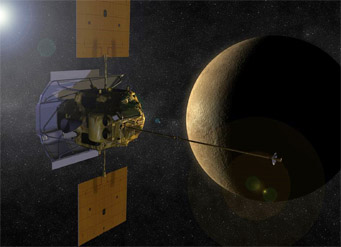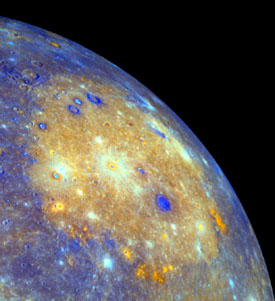NASA's emissary to Mercury just celebrated the eighth anniversary of its launch from Cape Canaveral in 2004. Here's a recap of some of the stuff we've learned about Mercury since Messenger arrived at the Iron Planet.
Last Friday, NASA’s Messenger spacecraft celebrated the eighth anniversary of its launch from Cape Canaveral as it set out for Mercury. Messenger (short for MErcury Surface, Space ENvironment, GEochemistry, and Ranging) first flew by the puzzling little Iron Planet in 2008 and went into orbit in 2011.

An artist's portrayal of the Messenger spacecraft after its arrival at Mercury.
NASA
I wrote about the results of that first flyby back when I was a starry-eyed S&T intern (now I'm a starry-eyed editor), noting that planetary scientists had several questions they wanted to answer with Messenger data. At the time I listed three of those questions:
“What’s with the weird-looking surface? Why does Mercury have a magnetic field? Is that water ice in those permanently-shadowed polar craters?”
Since then, planetary scientists have come a long way toward answering these and other questions. They’ve confirmed that the vast plains stretching across the surface are from volcanic outflows and that scarps in its surface were created when the whole planet shrank a bit. They’re also pretty sure that water ice indeed lurks just beneath the surface of those shadowy north-pole craters. And they've mapped nearly all of the planet's surface; in fact, this week the International Astronomical Union approved names for nine craters on Mercury's surface.
But they’ve also found mysterious, shallow hollows in the surface that might or might not be related to geological activity. And the magnetic field is still perplexing. As our contributing editor Kelly Beatty noted in his April 2012 feature article, Messenger data suggest that the planet’s magnetic field doesn’t originate in its core. Instead, it’s centered higher up toward the north pole, near the core-mantle boundary.
Below, you’ll find a selection of some of S&T’s online Messenger coverage since the 2004 launch. You can also purchase the April 2012 issue with Kelly’s article, either as a print copy or as a PDF download through our online store.
Mercury Bound!—August 2004. Messenger takes off for the Iron Planet.
Reunion with Mercury—January 2008. Kelly Beatty takes a personal look at the Messenger mission and why he's excited by it.

Enhanced color image of the Caloris basin and surrounding area on Mercury's surface. The orange tinges mark places where past volcanism has affected the surface.
Science / AAAS
Mercury: The Incredible Shrinking Planet—July 2008. My little intern look at Messenger's first flyby.
The New Face of Mercury—October 2008. Messenger's second flyby reveals parts of the planet that never seen up close before. More on that "new" hemisphere in Mercury Gets a Second Look—October 2008
More of Mercury Revealed—May 2009
Messenger’s Third “Taste” of Mercury—September 2009. The third flyby.
Mercury Throws Geologists a Curve—November 2009. The planet's weird composition leaves scientists scratching their heads.
Messenger: Mercury’s New Moon—March 2011. Messenger goes into orbit. Also in Messenger Gets to Work—March 2011
Mercury Shows its True Colors— October 2011
Is Mercury Alive After All?—October 2011. The weird shallow pits are found.
March Madness on Mercury—March 2012. Kelly Beatty looks at the latest results from Messenger, including the water-ice observations.
 1
1
Comments
Jaime
August 11, 2012 at 2:42 pm
Congratulations Nasa.
You must be logged in to post a comment.
You must be logged in to post a comment.